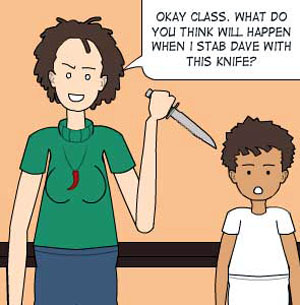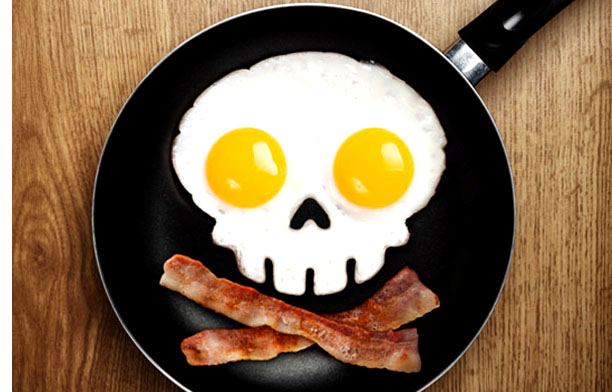Wholesome Horror
Horror as a genre, is like the carnival geek; it evokes ridicule, misunderstanding and has had a history of being looked down upon by the masses. But to some, like me, it’s way cool.
In recent years, shows like The Walking Dead have brought the horrific from the shadows and at least onto cable. Entire On Demand networks like FearNet offer the best in horror movies 24 hours a day for a price, because demand is low, even On Demand. Then we come to Halloween and, once a year, even the moms and the olde folks (no offence moms and olde folks) are a little more embracing of horror.
I see this as a key time for a little Horror evangelism and apologetics. The door of the horror unbeliever’s heart is a little more open…so what should we slip in? Many of us congregants in the house of horror try to slip in some of our favorites. For me it’s always Wes Craven—New Nightmare, if I think the person knows who Freddy is and can handle the more cerebral 4th wall breaking. But I call that tactic flawed, and call myself on the carpet before all.
I should skip the movie in favor of a concept, or at least share the concept first: Horror stories, no matter their medium, are wholesome and healthy for the mind, character and even the body.
Horror Supports Morality
“The greatest trick the devil ever pulled was convincing the world he doesn’t exist.”
-Charles Baudelaire, French Poet
 Dr. Michael Welner, MD is pioneering work on the Depravity Scale, with the “goal of distinguishing the worst of crimes” because he, and his like-minded board, have found that society is lacking a clear statute of what is evil and what is…less evil. Not so with Horror. Horror stories will quickly show you where the evil hides and what evil it is up to. In Horror, unlike in life, the struggle between good versus evil is concrete. Dr. Welner believes that the Depravity Scale “must…incorporate…current diagnostic understandings, the clinical experience of evil from a range of forensic sciences beyond psychiatry, and attempts to define evil by law,” and that statement puts forth the scientific belief that evil is real and definable. Horror’s been saying that since Jacobs’ The Monkey’s Paw.
Dr. Michael Welner, MD is pioneering work on the Depravity Scale, with the “goal of distinguishing the worst of crimes” because he, and his like-minded board, have found that society is lacking a clear statute of what is evil and what is…less evil. Not so with Horror. Horror stories will quickly show you where the evil hides and what evil it is up to. In Horror, unlike in life, the struggle between good versus evil is concrete. Dr. Welner believes that the Depravity Scale “must…incorporate…current diagnostic understandings, the clinical experience of evil from a range of forensic sciences beyond psychiatry, and attempts to define evil by law,” and that statement puts forth the scientific belief that evil is real and definable. Horror’s been saying that since Jacobs’ The Monkey’s Paw.
From a spiritual perspective, as a former atheist, I’ve seen American society from both sides of the religious fence, and I’ve always been intrigued by how often the most Christian of Christians will have a poor opinion of Horror movies and books. Yes, there are worldly elements of gore and profanity and sex, but usually those are cast in a bad light. Often, such as in The Exorcist, The Exorcism of Emily Rose, The First Power and many more, faith (good) is portrayed as the hero or the tool of the hero’s victory over either the supernatural, something arcane, some aspect of sin run rampant, something demonic or Satan himself.
The essence of morality, as defined by dictionary.com is “conformity to the rules of right conduct” and in Horror, less so in life, the “rules of right conduct” are clearly defined.
Horror Teaches
“A group of young people appeared in a movie with a psychotic killer…a shallow batch of hedonists, died before the opening credits…[a second group] like the first group, their “eat, drink, and be merry” attitude made them easy prey when the killer arrived. Others …defined by their accomplishments in athletic and intellectual pursuits, which spoke to their discipline and depth of commitment…sought to return to their dying world, and with it, they perished. But there was one in this group who entered as an outsider, one with depth of character and the ability to throw off anything that entangled her…face the judgment that claimed her friends, and survive.”
-N. Paul Williams, Horror Writer
Re-telling Matthew 13:3-8, Jesus’ Parable of the Sower as a Slasher Film.
The fun begins once the “rules of right conduct” are defined, because horror writers have something to teach—though they teach it through violence and gore. Greats like Koontz, King, Barker, Carpenter, Craven could be modern day Solomons writing Proverbs to the masses, Aesops writing fables to eager movie going Greeks or, messiahs on the digital mount sharing parables to internet disciples.
 These stories, these teaching tools, have a formula. “Slashers have their origins in some unresolved wrong, and the victim pool is often a reflection of that offense,” Williams (above) asserted. “Jason drown because they were too involved with each other…Fred Krueger died when a mob of vigilante parents from Elm Street decided that this child killer wouldn’t be allowed to slip through the cracks of the justice system,” and a price had to be paid. Incidentally, the Elm Street parents would have been for Welner’s Depravity Scale. (Williams, 2013) In Horror stories, there is a seeking of balance, if not always justice. The villain, as Williams noted, is seeking this balance, but in doing so has created an even greater imbalance. The hero then must provide the ultimate, corrective balance—usually taking the form of creative annihilation of the evil guy, which is always a thrill.
These stories, these teaching tools, have a formula. “Slashers have their origins in some unresolved wrong, and the victim pool is often a reflection of that offense,” Williams (above) asserted. “Jason drown because they were too involved with each other…Fred Krueger died when a mob of vigilante parents from Elm Street decided that this child killer wouldn’t be allowed to slip through the cracks of the justice system,” and a price had to be paid. Incidentally, the Elm Street parents would have been for Welner’s Depravity Scale. (Williams, 2013) In Horror stories, there is a seeking of balance, if not always justice. The villain, as Williams noted, is seeking this balance, but in doing so has created an even greater imbalance. The hero then must provide the ultimate, corrective balance—usually taking the form of creative annihilation of the evil guy, which is always a thrill.
The first Scream movie, written by Kevin Williamson, is a great example of the horror genre’s teachable lessons on healthy behavior, such as “You may not survive the movie if you have sex…You may not survive the movie if you drink or do drugs…You may not survive the movie if you say ‘I’ll be right back’, ‘Hello?’ or ‘Who’s there?’” That last one may not be initially as obvious as the first two, but its message becomes clear with a little unpacking; it’s about how to healthily handle dangerous situations. Don’t be overconfident and don’t wait for the negative to just happen to you; run.
Dirk Eitzen’s of the Society for Cognitive Studies of the Moving Image posited his research that most enjoyment of horror stories centered around how to handle danger. Eitzen’s research discovered that we may put ourselves in these hyper-dangerous horror story scenarios to learn, test and train our minds. “By entertaining imaginary dangers, we rehearse responses to actual or possible dangers. In this way, we develop important survival skills [and] take situations, including painful or sad situations such as death, and think through how we might or should respond to them.” In the final analysis, horror teaches by broadening the mind, stretching the synapses either by confrontation with the supernatural or the depraved. Horror seeks to impart “Cognitive Mastery” of the inescapable unknown danger of life as “by trying to comprehend it,” in story form “we take a step toward being able to manage or control it. This is a uniquely human capacity, but it addresses a basic biological need, by helping us feel and be safe.” (Eitzen, 2010)
Horror is Cardio
“I think most people, even if they say they hate horror movies,
there’s that feeling you get inside that you love. I mean, I love it.”
-Barry Watson, actor
 Fitness experts, doctors and various surgeon generals have all extolled the virtue of working your heart muscle. Flipping the channels of your cable box, late night, will afford you with countless approaches for how to up that heart rate. According to a Texas State University Study, you could just watch a horror movie.
Fitness experts, doctors and various surgeon generals have all extolled the virtue of working your heart muscle. Flipping the channels of your cable box, late night, will afford you with countless approaches for how to up that heart rate. According to a Texas State University Study, you could just watch a horror movie.
Similar to exercise “the experience of fear and its physiology is a group effort provided by multiple systems within the body and in the brain” and one of the end results of that effort is to flood the bloodstream with a cocktail of “adrenaline and cortisol, increasing blood pressure and increasing the metabolic rate needed to react appropriately to survive.” (Palmer, 2008) Horror stories trigger the fight-or-flight overdrive of the human body, and if nothing else, the calorie burn might offset a fun-size candy bar on Halloween night.
Halloween night. It’s coming. That one night a year that horror is welcomed into the homes of America. Horror; a bastion of morality, a beacon of education, a beater of hearts, it deserves to stand proud in the spotlight a shoulder-to-shoulder with other stories year round. But horror will not. Horror is content to lurk in the shadows, whispering its wisdom only to those brave enough to enter the darkness…and return changed forever.
__________________________________________________
Depravity Scale.org (2013). The Forensic Panel. Retrieved From: https://depravityscale.org/depscale/
Eitzen, Dirk. (2010). The Fun of Fear: Horror, Suspense, and Halloween. Society for Cognitive Studies of the Moving Image. Retrieved From: http://scsmi-online.org/forum/the-fun-of-fear-horror-suspense-and-halloween
Palmer, M. (2008). Fear: A Psychophysiological Study of Horror Film Viewing.
Texas State University-San Marcos. Retrieved From: https://digital.library.txstate.edu/handle/10877/3220
Williams, N.P. (2013). The Parable of the Slasher Film. New Authors’ Fellowship. Retrieved From: http://newauthors.wordpress.com/2013/08/31/the-parable-of-the-slasher-film/

